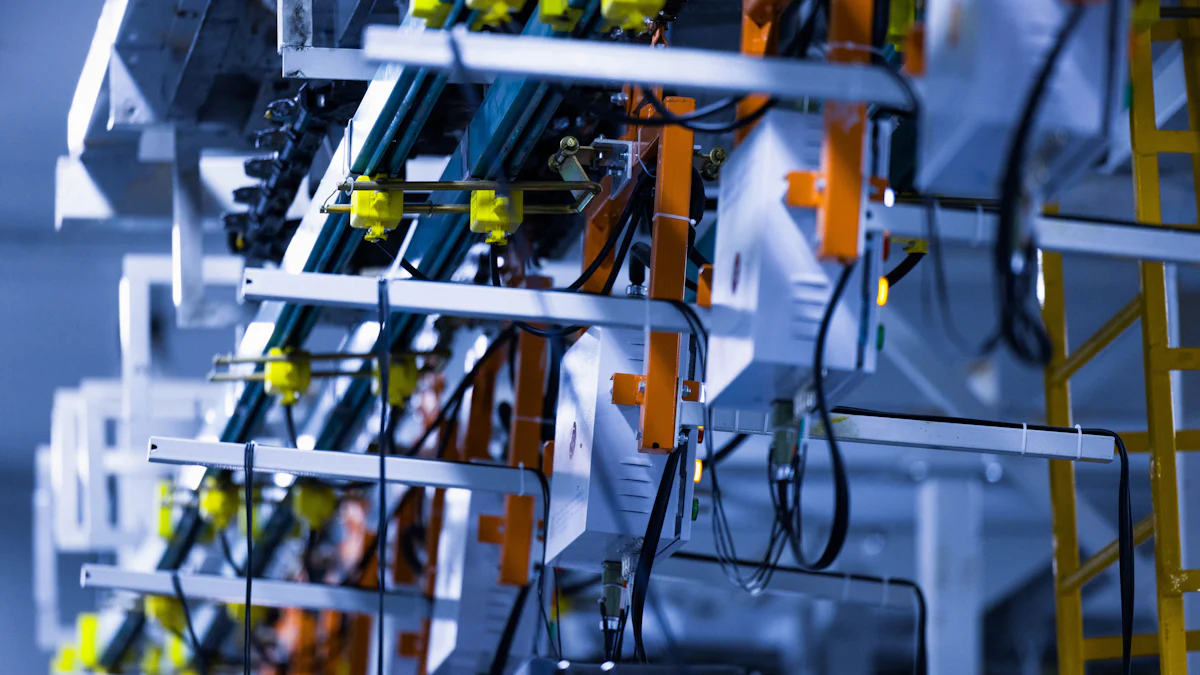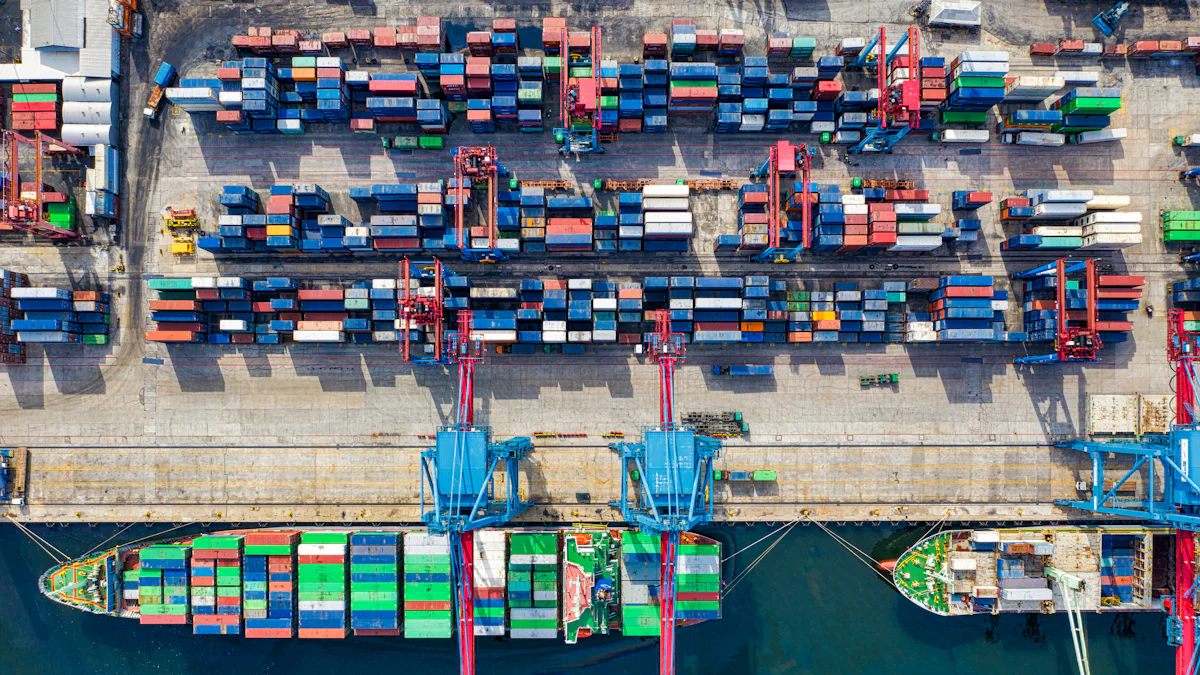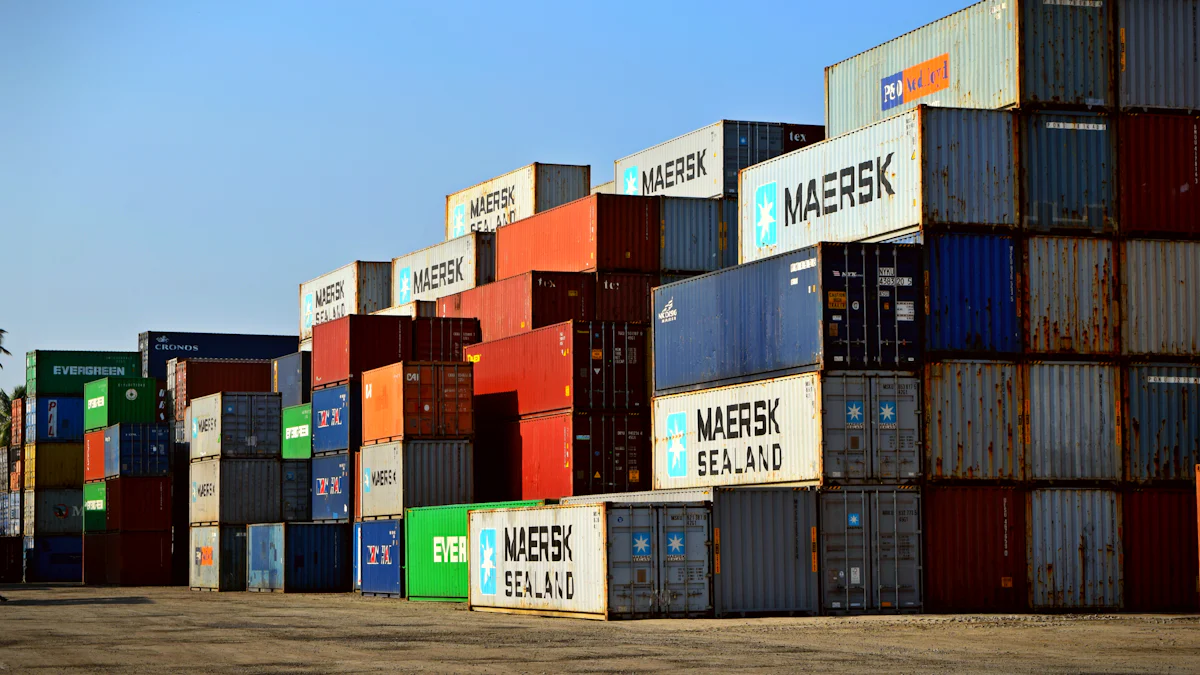The Strategic Application of IoT in Logistics

The application of the Internet of Things (IoT) in logistics revolutionizes the industry. IoT involves interconnected devices that collect and exchange data, enhancing operational efficiency. The importance of IoT in modern logistics cannot be overstated. IoT implementation could reduce logistics costs by 15% and improve inventory levels by 35%. The global IoT logistics market is projected to grow significantly, reaching $93 billion by 2028. This blog strategically focuses on how IoT transforms logistics, providing insights into its potential impact on the industry.
The application of the Internet of Things (IoT) in logistics

Definition and Components
The application of the Internet of Things (IoT) in logistics involves various components that work together to enhance efficiency and accuracy.
Sensors and Devices
Sensors and devices form the backbone of IoT systems in logistics. These include RFID tags and GPS trackers. RFID tags are small, wireless tags attached to items or packaging. They can be read remotely using RFID readers. This technology allows for real-time tracking of inventory and assets. GPS trackers provide location data for vehicles and shipments. This ensures accurate delivery and enhances route management.
Connectivity and Networks
Connectivity and networks enable communication between IoT devices. Wireless technologies like Wi-Fi, Bluetooth, and cellular networks facilitate this connectivity. These networks ensure seamless data exchange between sensors, devices, and central systems. This connectivity supports real-time monitoring and decision-making in logistics operations.
Data Processing and Analytics
Data processing and analytics play a crucial role in the application of IoT in logistics. IoT devices generate vast amounts of data. Advanced analytics tools process this data to extract valuable insights. These insights help optimize operations, predict demand, and improve supply chain responsiveness. Data analytics also aids in identifying trends and patterns, enabling proactive decision-making.
Historical Context and Evolution
The application of the Internet of Things (IoT) in logistics has evolved significantly over the years.
Early Adoption in Logistics
The earliest stages of IoT in supply chains can be traced back to the development of Radio Frequency Identification (RFID) technology. In the early 2000s, RFID tags became popular for tracking products in supply chains. Industry leaders such as FedEx and Maersk were at the forefront of this revolution. Logistics managers used location management tools and software for tracking deliveries. RFID technology reduced inventory levels and improved supply chain visibility.
Technological Advancements
Technological advancements have further propelled the application of IoT in logistics. Modern IoT systems integrate advanced sensors, connectivity solutions, and data analytics. These advancements enhance the accuracy and efficiency of logistics operations. IoT technology now automates inventory management and optimizes storage and transportation. Sensors and RFID tags track the status and position of inventory items. These innovations increase productivity, ensure cargo integrity, and improve delivery accuracy.
Applications of IoT in Logistics
The application of the Internet of Things (IoT) in logistics has transformed various aspects of the industry. IoT technology enhances operational efficiency and provides valuable insights for decision-making. This section explores key applications of IoT in logistics.
Real-time Tracking and Monitoring
Fleet Management
Fleet management benefits significantly from IoT technology. Companies use GPS trackers to monitor vehicle locations. Real-time data helps optimize routes and reduce fuel consumption. Fleet managers receive alerts about vehicle conditions. These alerts prevent breakdowns and ensure timely maintenance. IoT-enabled fleet management improves delivery accuracy and reduces operational costs.
Inventory Management
Inventory management becomes more efficient with IoT devices. RFID tags and sensors track stock levels in real time. Automated systems provide alerts when inventory reaches critical levels. Companies maintain optimal stock levels and avoid overstocking. IoT technology reduces inventory carrying costs and improves supply chain responsiveness.
Predictive Maintenance
Equipment Health Monitoring
IoT technology enables equipment health monitoring. Sensors collect data on machinery performance. Analytics tools process this data to predict equipment failures. Maintenance teams schedule repairs before breakdowns occur. This proactive approach minimizes downtime and extends equipment lifespan. IoT-based health monitoring ensures smooth logistics operations.
Cost Reduction Strategies
Predictive maintenance reduces operational costs. Companies avoid costly emergency repairs by addressing issues early. Scheduled maintenance improves resource allocation and reduces labor costs. IoT technology supports cost-effective maintenance strategies. Logistics companies achieve significant savings through predictive maintenance.
Supply Chain Optimization
Demand Forecasting
IoT technology enhances demand forecasting accuracy. Sensors and analytics tools analyze market trends and consumer behavior. Companies adjust production and inventory levels based on these insights. Accurate demand forecasting reduces waste and improves customer satisfaction. IoT-enabled demand forecasting optimizes supply chain operations.
Route Optimization
Route optimization benefits greatly from IoT technology. GPS data provides real-time traffic information. Logistics companies adjust delivery routes to avoid delays. Route optimization reduces fuel consumption and improves delivery times.
The application of the Internet of Things (IoT) in logistics revolutionizes the industry. IoT technology enhances tracking, maintenance, and optimization processes. Logistics companies achieve greater efficiency and cost savings through IoT applications.
Benefits of IoT in Logistics

Increased Efficiency
Automation of Processes
The application of the Internet of Things (IoT) in logistics significantly enhances operational efficiency through automation. IoT devices automate various processes, reducing the need for manual intervention. Automated systems streamline tasks such as inventory management and order processing. This automation leads to faster operations and minimizes delays. Companies experience reduced labor costs and improved productivity. Automation also ensures consistency in operations, maintaining high-quality service standards.
Reduced Human Error
IoT technology reduces human error in logistics operations. Sensors and devices provide accurate data, minimizing mistakes in inventory tracking and shipment handling. Real-time data ensures precise decision-making and reduces discrepancies. Companies achieve higher accuracy in order fulfillment and delivery. This reduction in errors enhances customer satisfaction and builds trust with clients. The application of IoT in logistics fosters a reliable and efficient supply chain.
Enhanced Customer Experience
Improved Delivery Times
The application of the Internet of Things (IoT) in logistics improves delivery times. Real-time tracking provides accurate information on shipment locations. Companies optimize routes based on traffic conditions and delivery schedules. This optimization reduces travel times and ensures timely deliveries. Customers receive their orders faster, enhancing their overall experience. Improved delivery times contribute to higher customer satisfaction and loyalty.
Transparency and Communication
IoT technology enhances transparency and communication in logistics. Real-time updates keep customers informed about their shipments. Companies provide accurate delivery estimates and live tracking information. This transparency builds trust and confidence among customers. Effective communication ensures that clients remain informed throughout the delivery process. Enhanced transparency and communication elevate service standards and strengthen customer relationships.
Challenges and Considerations
Security and Privacy Concerns
Data Protection Measures
The integration of IoT in logistics introduces significant security and privacy concerns. Companies must implement robust data protection measures to safeguard sensitive information. IoT devices collect and transmit vast amounts of data, making them potential targets for cyberattacks. Secure architecture is essential to prevent financial and reputational losses from vulnerabilities. Organizations should adhere to data privacy rules and industry regulations to ensure compliance. Regular audits by certified development partners can help maintain security standards.
Regulatory Compliance
Regulatory compliance plays a crucial role in the application of IoT in logistics. Companies must adhere to laws such as GDPR and PIPEDA to protect personal information. These regulations emphasize accountability and consent in data handling. Establishing stringent data protection measures ensures compliance with legal requirements. Clear regulations and standards help address data privacy, security, and liability issues. IoT asset tracking can mitigate risks and reduce the likelihood of fines and penalties.
Integration and Interoperability
Legacy Systems
Integration and interoperability present challenges in IoT implementation. Many logistics companies rely on legacy systems that may not be compatible with modern IoT technology. Upgrading these systems requires significant investment and planning. Companies must assess their existing infrastructure and identify areas for improvement. Seamless integration ensures efficient data exchange and communication between IoT devices and legacy systems. Overcoming compatibility issues enhances operational efficiency and effectiveness.
Standardization Issues
Standardization issues pose another challenge in IoT adoption. The lack of uniform standards hinders interoperability between different IoT devices and platforms. Companies must navigate various protocols and technologies to ensure seamless operation. Industry-wide standardization efforts can facilitate better integration and collaboration. Establishing common standards enhances compatibility and reduces complexity in IoT implementations. Addressing standardization issues is vital for maximizing the benefits of IoT in logistics.
Future Trends and Implications
Emerging Technologies
AI and Machine Learning
Artificial Intelligence (AI) and Machine Learning (ML) are transforming logistics. AI optimizes delivery processes and increases automation. Logistics companies use AI to analyze large datasets. This analysis enhances decision-making and improves efficiency. AI predicts demand patterns and adjusts inventory levels. Machine Learning algorithms learn from historical data. These algorithms refine logistics operations over time. AI and ML reduce operational costs and enhance service quality.
Scientific Research Findings:
AI in Logistics has revolutionized supply chains, increased automation, and optimized delivery processes.
Blockchain in Logistics
Blockchain technology offers significant benefits to logistics. Blockchain creates a secure ledger for inventory and shipping data. This ledger enhances transparency and efficiency in operations. Companies use blockchain to ensure data traceability. Blockchain resolves compliance issues promptly. This technology improves visibility across the supply chain. Logistics firms benefit from enhanced security and reduced fraud risks.
Scientific Research Findings:
Blockchain technology contributes to higher efficiency, timely compliance resolutions, and enhanced visibility in supply chain management.
Blockchain creates a decentralized and secure ledger for inventory and shipping data, improving efficiency and transparency in logistics operations.
Long-term Impact on the Industry
Sustainability and Green Logistics
Sustainability is a growing focus in logistics. Companies adopt green logistics practices to reduce environmental impact. IoT technology supports sustainable operations. Sensors monitor energy consumption and emissions. Logistics firms optimize routes to minimize fuel usage. Green logistics enhances brand reputation and customer loyalty. Sustainable practices contribute to long-term industry viability.
Global Supply Chain Dynamics
Global supply chains face dynamic challenges. IoT and emerging technologies offer solutions. Companies use IoT for real-time tracking and monitoring. This tracking improves supply chain responsiveness. AI and blockchain enhance global supply chain coordination. These technologies facilitate seamless cross-border operations. Logistics firms adapt to changing market demands efficiently. Global supply chain dynamics evolve with technological advancements.
The strategic application of IoT in logistics has transformed the industry. IoT solutions provide real-time data on inventory levels, fleet locations, and shipment statuses. This technology enhances operational efficiency and customer satisfaction. Logistics companies benefit from improved supply chain visibility and reduced delivery times. IoT enables proactive decision-making and route optimization. The future of logistics will see the Io with AI the potential to to offer the IoT's impact on logistics will continue to grow. Emerging technologies like AI and blockchain will further enhance logistics operations. insights.
See Also
Tomorrow's Logistics Revolution: AI Supply Chain Transformation
Unlocking AI's Potential: Revealing Logistics Innovation
Digital Technology: Paving the Way for Future Logistics
High-Tech Manufacturing Success: Navigating Lean Logistics Strategies
